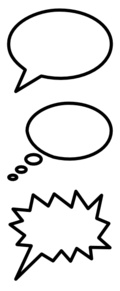Balloon
- Also see the page [ balloon fetishism ] for "Balloon fetish"
In comics (and sometimes also in cartoons), a balloon (also known as a bubble) is a closed line that encircles dialogue or thoughts.
Balloons are most commonly 'bubble' shaped, but can also have other shapes. Often, the shape of the balloon indicates whether a balloon shows thoughts, normal dialogue, or special types of dialogue such as a loud scream. Common types are:
- speech balloons/bubbles
- thought balloons/bubbles
- scream balloons/bubbles
- whisper balloons/bubbles
- broadcast balloons/bubbles
- icicle balloons/bubbles
Balloons usually have a pointer, called a tail, to point to the character that is speaking the dialogue. Thought balloons are most commonly cloud-shaped and have a tail that is a chain of increasingly smaller circular bubbles.
It is also possible to omit the balloon line completely. Scott Adam's minimalistic Dilbert comic strips, for example, frequently use this kind of "invisible balloons", in which a short dash between the character and the dialogue suffices.
Balloons are traditionally opaque white or in some other light color such as beige. Modern, digitally created comics sometimes experiment these days with semi-transparent balloons.
Film can do without balloons as the character's lip movement is sufficient to tell who is speaking. Thoughts are rarely expressed in film; occasionally thoughts are worded by an off-screen voice (usually the actor's own voice) with background sounds faded out, while showing the actor in deep thought.
Layout issues
Balloons are read in the same direction as the overall comic. In western comics, this is left-to-right (and top-to bottom, where applicable), while in Japanese manga, the reading direction is right-to-left (and top-to-bottom). To make a comic well readable, the artist must therefore carefully layout the characters and balloons in each panel so that the reading direction is taken into account.
Balloons tend to take up a great portion of the panel space (often, the upper half). To save panel space, some comic artists extend their balloons into the gutter above the panel, or even further, into the bottom of the panel above.
It is often visually better to break one big balloon into two or more smaller balloons. These can each point to the character, or can be "stacked" with connecting "channels" and a single tail.
See also
For other types of text used in comics, see captions and sound effects.
Chat rooms • What links here • Copyright info • Contact information • Category:Root
